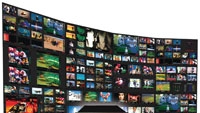Miranda's displays
Several key performance issues with multi-image processors have only recently been fully addressed with the latest generation of devices. These issues include delivering the highest level of picture definition across all image sizes and achieving full flexibility with layouts, without significantly compromising system scalability.
Delivering picture definition

Image quality for multi-image processors is important, especially for production studios, which represent the largest part of the multi-image market. Great strides have been made over recent years with respect to image definition and richness, both by manufacturers of multi-image processors and by flat-panel display vendors. However, multi-image devices have generally been based on off-the-shelf scaler chips designed for use in televisions, projectors and other display products. These chips do not deliver consistently sharp pictures as images are resized from partial to full frame.
Display flexibility with respect to image positioning, repetition and sizing has also traditionally been limited, especially as systems increase in size. This has led to situations in larger monitoring environments where the operator compromises the layout presentation in order to address the system's inherent blocking capabilities. Multiroom operation brings additional demands, with the ideal requirement for full flexibility at each operator position as far as layouts and source selection are concerned.
To address these issues, Miranda Technologies developed the Kaleido-X multi-image display system, which is based on a 7RU frame with up to 96 inputs, eight multi-image outputs and up to 48 HD/SD router outputs. A more compact, 4RU frame is also available for up to 32 inputs and four multi-image outputs. Both versions use the company's scaling technology, based on custom chips, to achieve a high picture quality across all window sizes. Images can be resized from tiny windows to full-screen display, without the loss of definition that is commonly associated with multi-image processors. For operators used to previous generations of processors, the level of quality improvement is immediately evident.
Achieving flexibility
Kaleido-X addresses the layout flexibility issue with its unique modular design, which provides unmatched, high-bandwidth performance. Any of a frame's 96 inputs can be displayed any number of times, at any size, in any position and on any display, without layout restrictions. This enables the operator to design an ideal monitoring environment without worrying about the processor's bandwidth limitations.
By using the system's midplane expansion module, two frames can be connected to allow the display of up to 192 video inputs over up to 12 displays. This configuration provides easy expansion without losing any of the system's extreme signal flexibility, due to the full interconnectivity of video, audio and metadata, as well as time code and control signals.
Multiple processors can be connected to create bigger systems by combining midplane expansion and router interconnects. This expansion path offers full scalability, while also offering a high level of signal flexibility. The processor also offers interfacing with third-party routers for greater system expansion so that the largest monitoring requirements can be addressed effectively.
This flexibility extends to multiroom and multioperator monitoring environments. Each room or pod can have fully independent display layouts, with totally independent control using a dedicated remote panel. However, all sources can be shared across the operators to simplify any reconfiguration required, such as to handle more or fewer channels, as commonly happens during night shifts when there are reduced operator crews.
Another dimension to the processor's flexibility is its full multiformat operation, with video accepted using HD/SD/analog autosensing inputs, and optionally by DVI or MPEG inputs. The video can be presented in a range of aspect ratios, and the displays can be either horizontal or vertical.
Operators can make the most of this extreme flexibility, using either familiar mouse control or a compact remote panel. Simple-to-use, mouse-operated on-screen drop-down menus are contextual to speed operations and offer numerous functions, such as changing aspect ratios, checking the safe area, assigning an input and changing text in a UMD. Users can also instantly change layout configurations and dynamically zoom one source larger for quality control or audio monitoring of an on-screen source. Layout creation is also intuitive, even for complex multiroom setups.
Reliability
These advances in quality and flexibility are not at the expense of system reliability. The Kaleido-X system is based on a highly robust frame design, with multiple points of redundancy and without a single point of failure for continuous 24/7 operation. The 4RU and 7RU frames both use front-loading, hot-swappable modules and power supplies. All the modules are independent, and there is no single module that can cause the system to fail.
The processors also offer multiple failover scenarios, an easy upgrade process, and detailed system status and logging. They use a real-time Linux-based operating system, and data is distributed for redundancy. Each output module has its own processor, operating system and external connections. Therefore, when a new output module with a different software/firmware version, IP address or configuration is installed, it will be reconfigured automatically by the other cards in the system, without intervention from the operator. All these features mean that the design offers true resilience for the most critical monitoring applications.
Louis Caron is product development manager, multi-image display, for Miranda Technologies.
Get the TV Tech Newsletter
The professional video industry's #1 source for news, trends and product and tech information. Sign up below.
